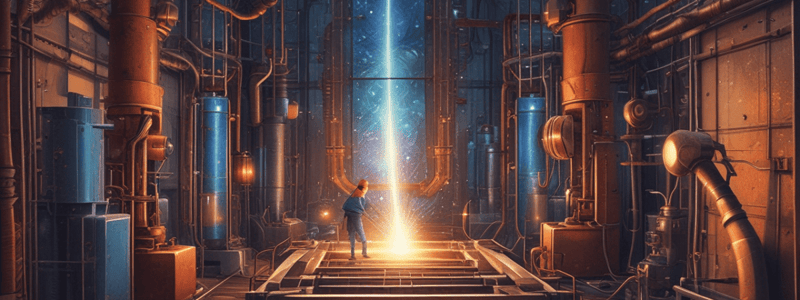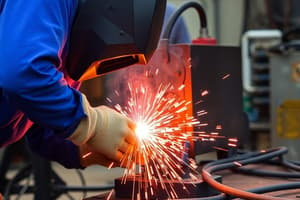Podcast
Questions and Answers
What is the primary difference between fusion welding and brazing?
What is the primary difference between fusion welding and brazing?
- The use of filler material
- The type of metal used
- The temperature of the base metal (correct)
- The type of flame used
What type of gas is commonly used in place of acetylene for welding aluminum?
What type of gas is commonly used in place of acetylene for welding aluminum?
- Helium
- Hydrogen (correct)
- Oxygen
- Nitrogen
What is the primary purpose of the oxygen cylinder in oxyacetylene welding?
What is the primary purpose of the oxygen cylinder in oxyacetylene welding?
- To mix with the acetylene gas
- To produce a high-temperature flame (correct)
- To clean the weld area
- To cool the welding torch
What is the primary function of the welding goggles in oxyacetylene welding?
What is the primary function of the welding goggles in oxyacetylene welding?
What type of welding process is oxyacetylene welding an example of?
What type of welding process is oxyacetylene welding an example of?
What is the purpose of the flint or spark lighter in oxyacetylene welding?
What is the purpose of the flint or spark lighter in oxyacetylene welding?
What is the primary advantage of gas metal arc welding over manual metal arc welding?
What is the primary advantage of gas metal arc welding over manual metal arc welding?
What is the common name for manual metal arc welding?
What is the common name for manual metal arc welding?
What is the primary function of the gas in gas metal arc welding?
What is the primary function of the gas in gas metal arc welding?
What are the three types of electric arc welding mentioned in the content?
What are the three types of electric arc welding mentioned in the content?
What is the characteristic of the electrode in manual metal arc welding?
What is the characteristic of the electrode in manual metal arc welding?
What is the typical arrangement of a manual metal arc welding circuit?
What is the typical arrangement of a manual metal arc welding circuit?
What is the function of the power supply in the GMAW welding process?
What is the function of the power supply in the GMAW welding process?
What type of welding is well-suited for large-volume manufacturing and production work?
What type of welding is well-suited for large-volume manufacturing and production work?
What is the primary function of the stream of inert gas in GTAW?
What is the primary function of the stream of inert gas in GTAW?
What is the role of the tungsten rod in GTAW?
What is the role of the tungsten rod in GTAW?
What type of welding is preferred for use on stainless steel, magnesium, and most forms of thick aluminium?
What type of welding is preferred for use on stainless steel, magnesium, and most forms of thick aluminium?
What is not a characteristic of GMAW?
What is not a characteristic of GMAW?
What is the angle at which the electrode should be held when making a fillet weld in a lap joint?
What is the angle at which the electrode should be held when making a fillet weld in a lap joint?
In a butt joint, what is the purpose of a filler rod?
In a butt joint, what is the purpose of a filler rod?
When making a fillet weld in a tee joint, how should the electrode be tilted?
When making a fillet weld in a tee joint, how should the electrode be tilted?
What is the purpose of beveling the edges in a butt joint?
What is the purpose of beveling the edges in a butt joint?
What type of joint is used for metals 1.6-3.2 mm thick?
What type of joint is used for metals 1.6-3.2 mm thick?
In a flanged butt joint, what is the purpose of turning up a flange?
In a flanged butt joint, what is the purpose of turning up a flange?
What is the primary function of leaving a gap between parts in a tee joint?
What is the primary function of leaving a gap between parts in a tee joint?
What type of joint is formed when the edge or end of one piece is welded to the surface of another?
What type of joint is formed when the edge or end of one piece is welded to the surface of another?
What is the purpose of beveling the vertical member in a tee joint?
What is the purpose of beveling the vertical member in a tee joint?
What is the characteristic of an edge joint?
What is the characteristic of an edge joint?
What is the purpose of filler rod in an edge joint?
What is the purpose of filler rod in an edge joint?
What is the reason for bending the edges of one or both parts upwards in an edge joint?
What is the reason for bending the edges of one or both parts upwards in an edge joint?
Flashcards are hidden until you start studying
Study Notes
Introduction to Welding
- Fusion welding is a process that involves melting the edges of two metal pieces to join them together.
- There are three general types of fusion welding: gas, electric arc, and electric resistance.
Gas Welding
- Gas welding involves heating metal parts to a molten state using a high-temperature flame.
- The oxyacetylene flame is produced by burning acetylene and mixing it with pure oxygen.
- Hydrogen can be used in place of acetylene for aluminum welding.
- The equipment used in gas welding includes two cylinders (acetylene and oxygen), pressure regulators, hoses, a torch, and safety gear.
Electric Arc Welding
- Electric arc welding is used extensively in the aircraft industry for both manufacturing and repair.
- There are four types of electric arc welding: manual metal arc (MMAW), gas metal arc (GMAW), gas tungsten arc (GTAW), and flux cored arc (FCAW).
Manual Metal Arc Welding (MMAW)
- MMAW is also known as "stick" welding.
- The equipment consists of a metal wire rod coated with a welding flux, clamped in an electrode holder connected to a low-voltage, high-current source.
Gas Metal Arc Welding (GMAW)
- GMAW was formerly known as metal inert gas (MIG) welding.
- An uncoated wire electrode is fed into and through the torch, and an inert gas (argon, helium, or carbon dioxide) flows out around the wire to protect the puddle from oxygen.
- GMAW is suitable for large-volume manufacturing and production work, but not for repair work.
Gas Tungsten Arc Welding (GTAW)
- GTAW is preferred for welding stainless steel, magnesium, and thick aluminum.
- A tungsten rod is used as the electrode, and a stream of inert gas (argon or helium) flows out around the electrode.
- A filler rod is manually fed into the molten puddle in a manner similar to oxyacetylene welding.
Welded Joints
- There are three basic types of joints: butt, tee, and edge joints.
Butt Joints
- A butt joint is made by placing two pieces of material edge to edge, without overlap, and then welding.
- A plain butt joint is used for metals 1.6-3.2 mm (1/16-1/8 in.) in thickness.
- A flanged butt joint is used for thin sheets 1.6 mm (1/16 in.) thick or less.
Tee Joints
- A tee joint is formed when the edge or end of one piece is welded to the surface of another.
- Tee joints are commonly used in aircraft construction, particularly in tubular structures.
- The plain tee joint is suitable for most thicknesses of metal used in aircraft, but heavier thicknesses require beveling to permit heat penetration.
Edge Joints
- An edge joint is used when two pieces of sheet metal must be fastened together and load stresses are not important.
- Edge joints are usually made by bending the edges of one or both parts upwards and welding along the outside of the seam formed by the two joined edges.
Studying That Suits You
Use AI to generate personalized quizzes and flashcards to suit your learning preferences.





